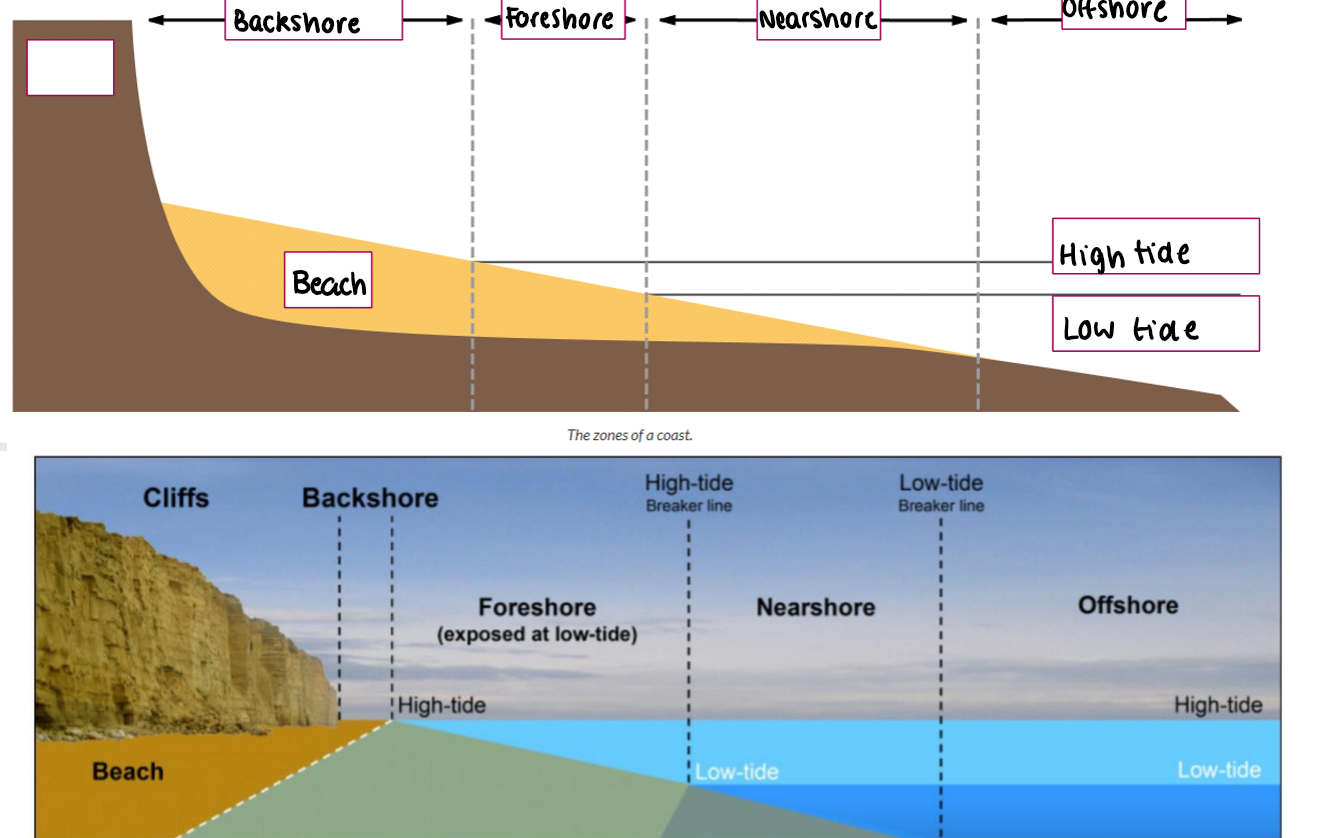Coastal landscapes as systems
1/16
There's no tags or description
Looks like no tags are added yet.
Name | Mastery | Learn | Test | Matching | Spaced |
|---|
No study sessions yet.
17 Terms
What is a coast
a narrow strip of shoreline where the sea and land interact and is shaped and influenced by both natural and human activity within a powerful ‘system’
land, air, and sea meet at the coast, making it a constantly changing environment
also is affected by human activity
unique combination creates a dynamic environment where change occurs frequently
The coastal zone

What is a system
a system is a set of interrelated stores and processes that are connected together to form a working unit
open system - a system in which energy and matter can flow in and out of the system, both energy and matter can cross the system boundary to and from the surrounding environment
closed system - a system in which energy can flow in and out but mater cannot leave and cannot be added, the matter is cycled within the system and only energy transfers across the system boundary to or from the surrounding environment
Energy inputs into the coastal system
the coastal system is driven by flows of energy within the inshore and foreshore zones, these flows of energy are the ones that enables work to be carried out by the natural geomorphic processes to shape the landscape
Flows of energy:
Solar energy - from the sun, it is responsible for atmospheric processes such as winds which generate waves
Kinetic energy - generated originally from solar energy, energy flows from the movement of wind, water and ocean currents
GPE - the movement of material downslope under gravity. Also, energy from the sun and moon converts to energy in tides
Geothermal energy - responsible for tectonic activity which can happen in coastal locations close to plate boundaries or faults
Inputs of energy
Thermal/Solar
GPE
Kinetic energy
Geomorphic processes
Weathering
Erosion
Mass movement
Transportation
Deposition
Outputs of energy
Energy is used up in geomorphic processes
Stores of sediment
Beach
Spit
Bar
Tombolo
Delta
Salt marsh
Inputs of matter
Longshore drift from another stretch of coast
Offshore zone
Aeolian transport from sand dune
Cliff erosion - scree
Fluvial input from river
Outputs of sediment
Longshore drift to another stretch of coast
Aeolian transport to sand dunes
Offshore zone
The coastal zone and equilibrium
Equilibrium - inputs and outputs of energy and matter are balanced
Coasts are dynamic - they change frequently
these changes caused by changes in energy flows e.g. wave energy in a storm
then, the system undergoes self-regulation and changes in order to restore the equilibrium
e.g. the shape of the coastline changes in response to the increased energy input
the system is then in a state of dynamic equilibrium - when equilibrium is in the the process of being restored
the system’s response is known as negative feedback
Negative feedback loop
this is a stabilising mechanism acting to oppose changes to coastal inputs and re-establish equilibrium
they have the opposite effect of the initial change
they can restore equilibrium quickly e.g. where sediment is involved, or over a longer timescale e.g. where rocky landform are involved
Negative feedback loop when a storm heavily erodes beach sediment
sediment eroded from the shore forms an offshore bar
this causes friction between the bar and incoming waves which dissipates its kinetic energy and forms a low energy constructed wave and deposits sediment on the beach
Negative feedback loop when a cliff erosion results in the formation of a wave cut platform
wave cut platform creates friction for the wave which dissipates its kinetic energy
so when the wave reach the back of the WCP, the energy of the wave is too little to erode the cliff
so no more sediment is added from the cliff so equilibrium is restored
Positive feedback loop
in contrast positive feedback pushes a coastal away from equilibrium and amplifies the initial change
e.g. at a cliff in equilibrium, high energy waves erode the cliff releasing angular sediment - this will then further erode the cliff via abrasion
Sediment cells
sediment cells are long stretches of coastline where sediment is sourced (inputs of sediment), where sediment flows (sediment is transferred due to inputs of energy), and where sediment is stored
the geomorphic processes of erosion, transportation, deposition, mass movement and weathering all take place and are largely contained within the sediment cells
a sediment cell is a closed system so no sediment is transferred from one cell to another
Sediment cells operating as a system
cells function independently from each other, the boundaries of the cells are determined by the topography and shape of the coastline
large features e.g. headlands such as the Llyn Peninsula in Wales act as huge natural barriers that prevents the transfer of sediment
coarse sediment is not exchanged between cells but fine sediment (sand) in suspension might be
it is unlikely that cells are fully closed because variations in wind direction and tidal currents might cause some sediment to be transferred between cells which makes them more open than the theory suggests
there are also many sub-cells of a smaller scale existing within the major cells